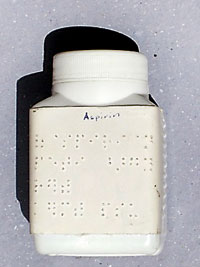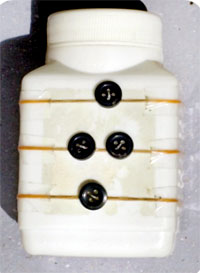Taking meds: A helping hand to the visually handicapped
View(s):By Dr. Chamari Weeraratne
Taking medicines is a challenge to people who have poor eyesight or are totally blind. Most of us believe that they are a dependent group whose medicine related needs are handled by their sighted relatives. However, pioneering local research on some blind persons in Sri Lanka recently reveals a different story. Most of them wanted to use medicines independently. Some of them lived separately without assistance and some lived with caretakers who went out to work during the day. Some were parents and had to give medicines to their children.
 They had many difficulties in using medicines some of which they tried to overcome by self-adopted coping strategies. They faced medicine related mishaps of a serious nature.
They had many difficulties in using medicines some of which they tried to overcome by self-adopted coping strategies. They faced medicine related mishaps of a serious nature.
Barriers to medicine use
1. They had environmental and physical barriers in general practice settings, pharmacies and at home
They found it difficult to travel by public transport to their doctor’s practice, hospital clinic and the pharmacy. They complained that the public were sometimes unhelpful and did not know how to direct or assist them properly. Some buses would not stop for them. When in a queue to see the doctor or obtain medicines from the pharmacy they had long waiting times since some patients overtook them in the queue taking advantage of their visual disability.
2. Poor access to information
They did not have ready access to information on the medicines they used. They could not read the medicine labels, prescriptions and medicines information leaflets that came with the medicine. A few medicine had Braille labels but since they were in English Braille most of them could not understand them. Some did not know how to use Braille at all.
 3. Barriers in self-administration of medicines
3. Barriers in self-administration of medicines
They had many barriers to self- administration of medicines as discovered from our local studies. They could not locate the medicine containers. They could not remember when to take different medicines since they could not read the medicine labels and instructions. They found it difficult to identify different medicine containers and different medicines. They found it difficult to take medicines out from blister packs and to divide tablets. They kept dropping the pills on the floor. Taking liquid medicines and measuring them was also a big challenge.
During the past few years I have led several groups of very keen and motivated researchers (medical students, doctors, trainee pharmacists and pharmacists). Together we have been able to explore a previously totally unexplored and neglected area of research in Sri Lanka and bring it to the attention of national and international audiences including the World Health Organization(WHO), Commonwealth Pharmacists Association, Global Doctors’ Organization(WONKA) and many other international and national scientific forums. We have also recognized many ways of helping the visually disabled to use medicines by themselves or with minimal assistance.
The following are some tips to assisting them.
All of us should recognize their difficulties and develop a caring attitude. It is our social responsibility to assist them when necessary. Address the visually disabled person by name, if you know it. Identify yourself by name too. Stay in one place, if possible, when you speak. It is hard for a blind person to try to face a speaker who is constantly moving around.
Be specific when you give directions to them. For instance say, “There is a door on your right.” rather than “There’s a door up ahead.” When seating a patient guide him by placing his hand on the top of the back rest of the chair.
Because of the wide range of visual impairments, different abilities and skills they have, it is important to use several options to provide the necessary information. Verbal communication is the main method of doing this since they can hear what the doctor, pharmacist and the relatives say. This is the most cost effective way of providing information to them and should be utilized maximally. It is important to include your visually disabled relative in the conversation with the doctor and the pharmacist. Most of them have expressed their displeasure at being left out from the conversations in these situations.
If the patient has some useful vision it should be corrected as much as possible with spectacles.
The information leaflets on medicines can be printed in large print using 16, 18, 20, or 22 point Ariel bold font depending on the individual patient’s level of vision. We can use a photocopier to enlarge existing information leaflets for them. They should be encouraged to use a large sheet magnifier to read instructions on medication labels if they can do so.
They can also make use of audio inputs effectively. The instructions on taking medicines can be recorded onto their mobile phone, a cassette recorder, a compact disc or data carrier depending on a person’s choice and computer skills. Some vision impaired computer users have software that turns text into speech or Braille and allows for easy text enlargement on the computer.
We can also help them to self- administer medicines safely. To remind the time to take medicines they can use the alarms in their talking wristwatches. These are given to them by the Sri Lanka Council for the Blind and other organizations from time to time.
They would be able to recognize different medicine if we store them in containers of different size, shape and texture. If they are able to recognize colours we can use containers of different colours for this purpose.
To indicate the number of times a medicine should be taken we can put elastic bands or thick rubber bands around the containers. We can ask the patient to think of the cap end of the container as morning end and the base of the container as the night end.
For example if the medicine is to be taken in the morning and night we can put two bands close to these two ends whereas if they are to be taken three times a day we can put 3 rubber bands accordingly. To indicate the number of tablets or capsules that should be taken for a particular dose we can stitch buttons on to the bands. If one tablet is to be taken in the morning we can stitch one button onto the rubber band depicting the morning. The visually disabled can touch the bands and the buttons on the different containers and learn when to take each medicine and what dose to take.
They should be advised to sit at a table when opening medicine containers. They should hold the container over a tray with raised edges so that the medicines do not get lost. All medicine containers should be kept on the patient’s left at the start. He should be educated to open each container one at a time, take the medicine out, close it and putting it on his right hand side so that he would not take the same medicine twice by mistake.
(Based on the speech made by the author at the World Organization of Family Doctors South Asian Regional Conference (WONKA SAR) held in Colombo in February)


